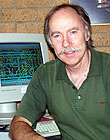 |
|
 Home Home
 Products Products
 Store Store
 Forum Forum
 Warehouse Warehouse
 Contact Us Contact Us

|
|
|
|
 
|
|
Author
|
Topic: Speaker-Amp wiring
|
Antonio Marcheselli
Phenomenal Film Handler

Posts: 1260
From: Florence, Italy
Registered: Mar 2000
|
 posted 04-07-2002 02:08 PM
posted 04-07-2002 02:08 PM





Let's suppose you have 2 JBL 4638 LF speaker for each stage channel. Let's suppose that in the booth you have 3 Crown 1201 Amp to drive them (we are in bi-amp).Let's suppose that the wiring is as follow: Amp1/Ch1 - LFR
Amp1/Ch2 - LFL Amp2/Ch1 - LFC
Amp2/Ch2 - LFR Amp3/Ch1 - LFC
Amp3/Ch2 - LFL Ok, in this way you'll have a failure protection because if one of the amp will fail there aren't channels that remain without LF sound. But... I think that for one night you could stay without LF on one channel if connecting the speaker to BRIDGED amp results in double power... Why don't the speakers has been wired as follow instead? Amp1-Bridged - Both LFC
Amp2-Bridged - Both LFR
Amp2-Bridged - Both LFL ??? ---- Another scenario: (I'm so dull!  ) 4 JBL 4645B ) 4 JBL 4645B  subwoofer and two JBL MPX600 wired as follow: subwoofer and two JBL MPX600 wired as follow: Amp1/Ch1 - SW1
Amp1/Ch2 - SW2
Amp2/Ch1 - SW3
Amp2/Ch2 - SW4 Luckily the subwoofer are actually wired as follow instead: Amp1/Bridged - SW1+SW2
Amp2/Bridged - SW3+SW4 I would like to know if in the channel/SW solution are there any advantages rather than Bridge mode. Basing on your answers I'll tell you where I found the first solution! I'm sorry if I ask always about the same systems but I would like to know everything about that because
1. Curiosity
2. I want to be able to answer to tech's lies  Bye
Antonio
| IP: Logged
|
|
|
|
|
|
Ray Derrick
Master Film Handler

Posts: 310
From: Sydney, Australia
Registered: Sep 2001
|
 posted 04-15-2002 08:08 AM
posted 04-15-2002 08:08 AM




AntonioWhen considering how you wire your speakers and amplifiers you should bear in mind the following: 1. The specifications for many amplifiers state that they give a higher TOTAL power output in bridge mode than they do if the two channels are operated independently. The reason for this is that the
power output for a two channel amp is usually measured using a single frequency sine wave tone applied inphase to both channels. As the sine wave swings positive, all of the power supply current is drawn from one side of the power supply (the positive rail) and as it swings negative all of the current is drawn from the other side (the negative rail). However in bridge mode, the sine wave is internally fed inphase to the the left channel and antiphase to the right, so the positive and negative sides of the power supply are even loaded at all times. This usually allows for a slight to moderate increase in total output power. 2. An amplifier will generally not produce twice the power into a 4 ohm speaker as it will into an 8 ohm speaker, it is usually somewhat less than double. This is mainly because the internal impedance of the amplifier output and the characteristics of the power supply are factors in determining output power at different load impedances. 3. 4 ohm and 8 ohm speakers are not created equal. You should check and compare the power output per watt specs when comparing similar speakers that have different impedances. 4. Running two speakers in parallel does not always result in even distribution of power between the two speakers. It is quite common for one speaker to draw a little more than the other particularly in different parts of the frequency spectrum due to normal production tolerances. Also when you connect two inductive loads in parallel there is usually some electrical interaction between them which can affect smoothness of response and efficiency. So running two speakers in parallel off a briged amp is not necessarily better than running the two speakers of their own individual channels. There are many factors at play and both methods have their own advantages.
------------------
Ray Derrick
President/Chief Engineer
Panalogic Corporation Sydney, Australia
Phone: 61 (0)2 9894 6655 Fax: 61 (0)2 9894 6935
| IP: Logged
|
|
Antonio Marcheselli
Phenomenal Film Handler

Posts: 1260
From: Florence, Italy
Registered: Mar 2000
|
 posted 04-16-2002 04:42 AM
posted 04-16-2002 04:42 AM





Thanks Ray, Thanks John.So, if single channel's power is enough, it could be better to wire the speaker/amp in stereo mode. However, in my situation I've calculated that room needs are about 400W and amps in stereo mode can provide just 400W. I believe that in this case a bridge setup could be better, right? For subwoofers, I calculated that in stereo mode the power isn't enought for that. So in that situation bridge mode is needed, right? Thanks for your replies. Bye
Antonio
| IP: Logged
|
|
|
|
All times are Central (GMT -6:00)
|
|
Powered by Infopop Corporation
UBB.classicTM
6.3.1.2
The Film-Tech Forums are designed for various members related to the cinema industry to express their opinions, viewpoints and testimonials on various products, services and events based upon speculation, personal knowledge and factual information through use, therefore all views represented here allow no liability upon the publishers of this web site and the owners of said views assume no liability for any ill will resulting from these postings. The posts made here are for educational as well as entertainment purposes and as such anyone viewing this portion of the website must accept these views as statements of the author of that opinion
and agrees to release the authors from any and all liability.
|
|
|
|

 Home
Home
 Products
Products
 Store
Store
 Forum
Forum
 Warehouse
Warehouse
 Contact Us
Contact Us




 Printer-friendly view of this topic
Printer-friendly view of this topic






 ) 4 JBL 4645B
) 4 JBL 4645B 





